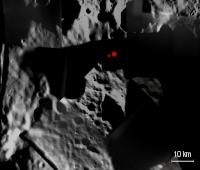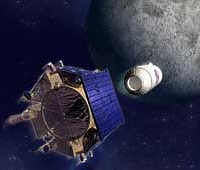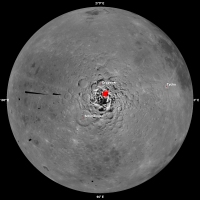SMART-1 images of new target site of upcoming LCROSS impact
8 October 2009
ESA's SMART-1 team has released new images of the proposed impact site of NASA's Lunar Crater Observation and Sensing Satellite (LCROSS), after the LCROSS team announced a new target last week. LCROSS will search for water ice on the Moon by making two impacts into the Cabeus crater at the lunar South Pole. The impacts are scheduled for 11:31 and 11:35 am UT on 9 October 2009.
 |

|
|
Left: SMART-1/AMIE mosaic of lunar surface at the new LCROSS target impact site (red dots): crater Cabeus. Credit: B. Grieger, B.H. Foing & ESA/SMART-1/AMIE team Right: Artist's impression of the LCROSS spacecraft and Centaur separation. Credit: NASA |
The new images have been retrieved from the SMART-1 database by Bjoern Grieger, the liaison scientist for SMART-1's AMIE camera, and Project Scientist Bernard Foing. The SMART-1 images are at high resolution as the spacecraft was near its closest distance of 500 km from the South Pole. The SMART-1 images of LCROSS potential targets were discussed on 18 September at sessions devoted to lunar science at the European Planetary Science Congress (EPSC) in Potsdam, Germany.
 |
|
The position of the SMART-1/AMIE mosaic images (red) indicated on a map of the Moon's southern hemisphere.
Credit: B. Grieger & ESA |
The LCROSS target was selected as the optimal location for that mission's evaluation of whether water ice exists at the lunar South Pole. The interior of Cabeus is permanently in shadow, so ice lying inside the crater is protected from the Sun's harsh rays. LCROSS will send the upper stage Centaur rocket crashing into Cabeus. A shepherd spacecraft will fly into the plume of dust generated by this first impact and measure its properties before making a second impact with the lunar surface. Astronomers will observe both impacts using ground and space-based telescopes.
The SMART-1 spacecraft also concluded its mission with a controlled impact on 3 September 2006. The event was observed with ground-based telescopes (a 'dry run' for LCROSS) and the flash from the impact was detected at infrared wavelengths.
Contact
Bernard H. Foing, ESA SMART-1 Project Scientist
E-mail: Bernard.Foing esa.int
esa.int
Bjoern Grieger, SMART-1 AMIE Liaison Scientist, ESAC
Email: Bjoern.Grieger esa.int
esa.int
Last Update: 1 September 2019

 esa.int
esa.int esa.int
esa.int


